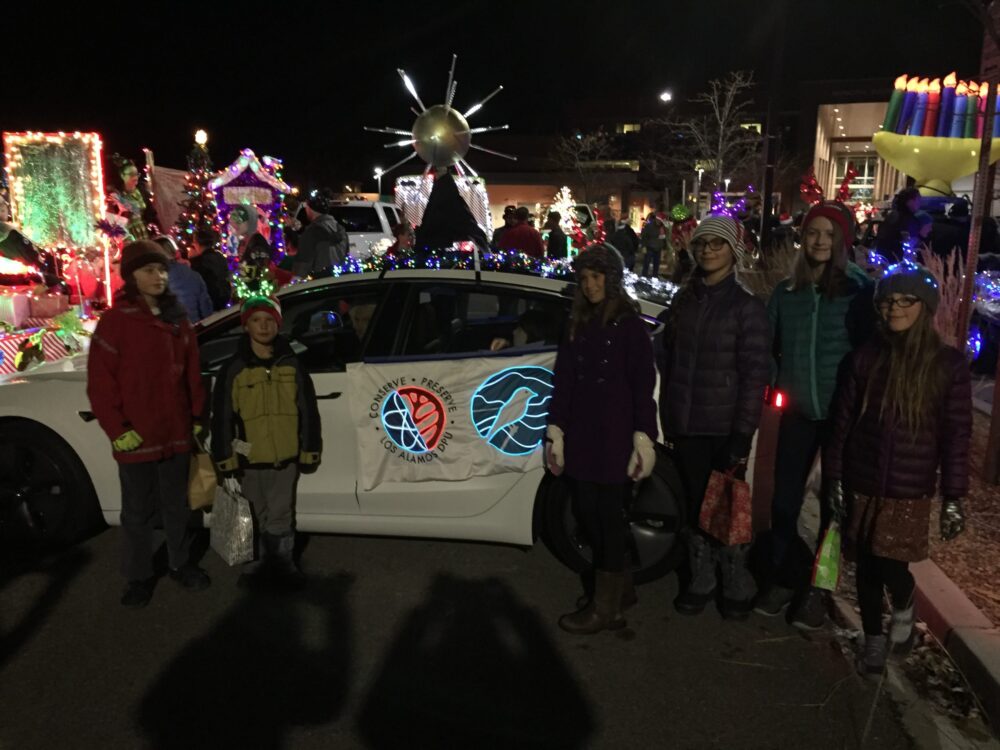By Elizabeth Watts

As we approach the winter solstice, the nights are getting longer. Many traditions around the world celebrate with lights during this darkest time of the year. Here in New Mexico, many of us decorate with farolitos (or luminarias depending on where you are from!). Whether you put up simple white lights or go full-Griswold, here are some tips on how to save energy and help protect our environment while brightening the dark nights of winter.
NASA is able to see changes in the amount of light produced in the US during the period from Thanksgiving to New Years. This has effects on energy use as well as on wildlife and on ecosystems. Nocturnal animals may be confused by nighttime lighting while animals that are active during the day can be out longer and have greater exposure to predators. Also animals are in general more sensitive to shorter wavelength (blueish) lights than we are. LED lights use much less energy than traditional lights, but some of them emit more blue light than traditional ones.
One impactful change you can make for both your energy bill and the environment is to not leave your outside lights on all night. This will use less energy and cause less disruption for wildlife. With holiday lights, set them up with an inexpensive outdoor timer, and turn them off by midnight. It’s Los Alamos — no one is out after 10 PM anyway! For regular outdoor lights on a carport or porch, look for LED bulbs that have a warm light instead of a blue light, are shielded, and that have a movement sensor so they only turn on when someone approaches. Lights that are shielded from shining up into the sky reduce sky glow. Check out more recommendations for outside lights from the International Dark Sky Association.
LED lights are much more efficient than incandescent lights, especially for larger sized holiday lights such as C9s. A string of 25 C9 incandescent lights uses 175 watts of power while a similar string of LEDs only uses 2.5 watts. For a string of 100 miniature lights, incandescent bulbs will use 40 watts compared to 7 watts for LEDs. This is less of a difference, but if you have multiple strings of lights, it can add up to a significant difference. Here is a handy online calculator that can show you how much energy you can save by using different types of lights. LED lights also have a longer lifespan than incandescent lights so even though they cost more initially, the total cost over 10 years is significantly less.
If you are investing in new outdoor lights this year, consider solar-powered lights. There are many styles and colors available. With solar lights, you won’t add to your energy bill. You also don’t have to run extension cords to use them so they are great for decorating places farther away from the house. Most solar lights have a sensor so they only come on when it’s dark outside. You can also try to find ones with a timer so that they don’t stay on too long. Some solar lights will stay on as long as they have power but others have a timer for two, four, or six hours. With a little internet searching, there are even solar-powered electric farolito/luminarias available!
Don’t forget to check out natural light displays this winter. Earlier sunset times mean that you can see the stars without staying up all night! Bundle up if it’s cold, and have some hot chocolate ready for when you come back in. The night of December 13 and morning of December 14 is the peak of the Geminid meteor shower. This year it coincides with a new moon so there are great conditions for viewing this shower. On the evening of the solstice, December 21, Jupiter and Saturn will be in conjunction just after sunset. This will be their closest approach to each other in our sky for 20 years.
If you have an energy-efficient holiday display, we’d love to see it! Send a picture to elizabeth@peecnature.org. We will also be decorating the treehouse at the Los Alamos Nature Center with solar-powered lights so come check that out, too!
For more tips on saving energy this winter, check out our home winterization post!

